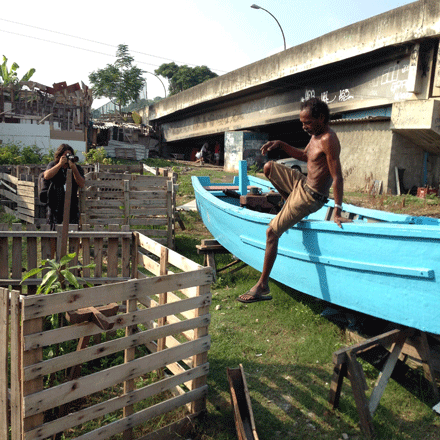By Peter Hossli

The Swiss journalist observing the scene and aiming to report on it doesn’t understand a word. And yet he is taking notes, because Dado Galdieri is translating for him while simultaneously taking pictures of the soldiers and the passerby.
Galdieri is a photographer, a fixer – and a driver. He’s wearing a pair of shorts and his hair is shoulder-length. A native of Rio, he knows this metropolis of 11 million very well, her stories, the people; he owns a car and can find his way through the creeping traffic.
The forty-year-old is a quick networker, to the benefit of the journalist flown in from Europe for his investigative piece on the social divide in Brazil. On the outskirts of the favela, Galdieri finds the fisherman Gabriel. He lives under a bridge, and because of the Soccer World Cup he will lose all of his belongings. Galdieri translates the reporter’s questions and dictates what Gabriel tells him. The following day he will drive the journalist to the marina in Rio and translate during his interviews with Brazilian millionaires.
Long before flying to Brazil, the journalist contacted the fixer, describing what he was looking for, whom he wanted to talk to, explaining the images he needed. But for the fixer he would have been lost in the foreign city. Now, he will go home with a good story.
Fixers – they are nameless and they have the foreign correspondents’ and reporters’ backs. If not for them, many stories would never be written. Unlike the foreign journalists they know the country, speak the language and are aware of possible dangers. Fixers frequently make the journalists’ travel arrangements.
They offer their services online. If a reporter wants to travel to Syria, he places a search on Facebook, specifying the city he wants to go to, and when. He will immediately receive the telephone numbers of many fixers and subsequently evaluate: Who is reliable? Who is still alive? Who can do what? Fixer and reporter will agree on a fee via e-mail, discuss travel details and arrange a meeting point.
Some fixers offer their services in hotels where Western correspondents stay. «Need a fixer?», they will ask outright. Supply and demand dictate the price. If the journalists are mostly freelancers, the fixers come cheap. As soon as the American TV channels arrive – CNN, FOX, ABC – prices soar. «When the Arab Spring began, my fixer didn’t want any money,» says a photographer who was working in Libya in 2011. «Half a year later he asked for 350 dollars a day.» Journalists pay in US dollars around the world; the rates are between 50 and 600 dollars, cash only.
A good fixer is impartial, which is difficult in regions of conflict. They often belong to a group that is at odds with another group. If the fixer is bad, he will take sides and translate with bias.
Fixers have been shaping the media for a long time. During the wars in Vietnam and Cambodia, American and French reporters employed local helpers to lead them through the jungle. When Yugoslavia fell apart in the 1990’s, fixers showed foreign reporters the way past the snipers. In 2003, fixers were a major influence on the reporting from the war in Iraq.
Sometimes the political situation will determine the fixers’ freedom of movement. Right now, very few fixers in Egypt are willing to work for foreign journalists, for fear of government repression.
Fixers are mostly male, young, lack a family and like to take risks. «It’s Always the Fixer Who Dies» was the title of a 2009 New Yorker article by George Packer. Fixers are quickly accused of being spies and traitors for working with the foreign media and thus with the enemy.
When things get tough, foreign reporters survive. Their fixers die. In 2007, the Taliban kidnapped an Italian journalist in Afghanistan. They beheaded his driver and killed the translator. The journalist was released.
On January 7, 2006, American journalist Jill Carroll was taken hostage in Iraq. Her driver and translator, Alan Enwiya, was shot dead. Carroll was released. In March 2012, Libyans released four New York Times journalists they had held hostage. Their driver, however, Mohamed Shaglouf, was shot.
Every year, the organization Reporters Without Borders publishes a list of journalists killed in action. We know nothing about the fixers killed in action. Only the tragic cases make it into the media. In late December 2013, 17-year-old photographer Molhem Barakat died in Aleppo. He was working for Reuters. The agency deplored his death and there was subsequent criticism about deploying underage amateurs in such dangerous regions. Especially since many media companies don’t insure their fixers and don’t take care of them in case of accidents.